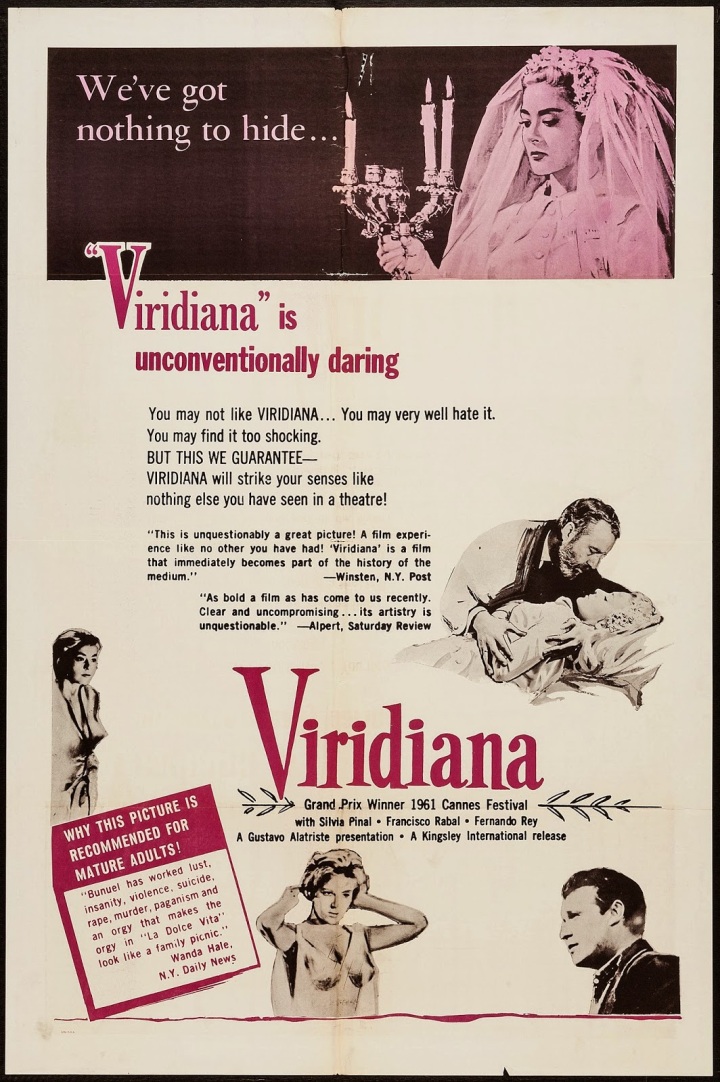Viridiana (1961) has quite a reputation among film critics and historians, often being listed as one of Luis Bunuel‘s best efforts. It is certainly among the most heterodox offerings in his considerable canon.
Viridiana marked Buñuel‘s return to his native Spain after a twenty-five year absence. With the fascist Franco still in power, Buñuel was severely criticized and accused of making his bed with the enemy, but the filmmaker’s critics should have known better. Buñuel had an ulterior motive, with a predictably incendiary opus tucked securely in his Surrealist vest pocket.
Upon receiving Buñuel’s original script, which ended with the protagonist nun engaging in ménage a trois with her cousin and his mistress, the government promptly rejected the story. Undaunted, Buñuel rewrote it, with all the implications gloriously intact through the trio joining in a card game inside the cousin’s bedroom. Having outwitted the censors, Bunuel congratulated himself over an even more immoral ending.
Despite Virdiana having won the Palme D’ or, the Spanish government was furious for having been so easily duped by the insurgent Surrealist, and banned him from the country until after Franco’s death. Predictably, the Vatican followed suit and condemned both filmmaker and film as blasphemous. Fortunately, attempts to burn all existing copies proved futile. It had to be a hell of a compliment to Buñuel, who soaked in his resounding success of provoking the status quo. Years later, when a pope removed a ban from one ofBuñuel’s films, the filmmaker was reported to have lamented: “What has my life and this world come to when even a pope accepts me?”
As one may expect of Buñuel, Viridiana is a far more labyrinthine composition than its shock publicity would indicate. Rooted within an anti-clerical, anti-pious battering ram is a film so intrinsically religious that its heterodox classification was inevitable.
An incandescent Silvia Pinel embodies the title character with such singularly stoic personality that her Buñuel followup as the Devil in Simon Of The Desert (1965) seems perfectly apt in hindsight.
Viridiana is content in her cloister, about to make her wedding vows to Christ, when Mother Superior orders her charge to visit uncle Don Jaime (Fernando Rey). He is Viridiana’s only living relative and, more importantly, a financial backer of the convent. Viridiana is the quintessence of objectified perfection, a forbidden Eve’s apple in a black habit. Viridiana is so thoroughly reduced to potential receptacle that she never entirely convinces as a novice, which was clearlyBuñuel’s motive. In typical Buñuel fashion, it is the ecclesiastical curator who throws the innocent out of a self-styled paradise into a fetishistic, reptilian den.
Dom Jaime could be seen as a prodigal’s uncle, lording over the remnant of his estate with the wayward niece returning from her explorations of a pious, alternative culture, as opposed to one of debauchery. The returning pariah is not treated to a celebration with fatted calf, prepared by the loyal servant maid. Rather, the servant aids and abets her master in drugging Viridiana in a pathetic effort to transform the virgin into a centerfold for “Necrophilia Illustrated.”
Disgusted with her uncle’s incestuous advances, Virdiana flees the homestead yet again, only to be stopped by the news that Dom Jaime has hung himself and left her half of his estate, which she will share with her cousin.
Viridiana’s interpretation of St. Paul’s dictum: “the greatest of these is charity” proves delightfully absurd when taking in the uneducated derelicts of the world. Buñuel shows the underclass as having sensibilities of cruelty and avarice equal to, if not surpassing, the affluent elite. “Sin” is not the sole property of a single social status. Both rich uncle and penniless leper like the feel of a garter on their thighs while squeezing into heels. Uncle and son seek to soil the unspoiled flesh. Viridiana’s self-humbling only squeaks with charitable intent. She is a counterpart to Buñuel‘s earlier, hopelessly naive Padre Nazario from Nazarin (1959).

The film contains two infamous scenes. The first is a cruelly symbolic one, involving two dogs and their carts. Bunuel choreographs the vignette like a rabid string duet, doused in venomous futility. It is a canine stations of the cross with Simon of Cyrene alleviating the dolorous passion of one mutt, only to be oblivious to the sight and sound of a second dog’s death march.
The second vignette is less restrained; a setting of da Vinci’s pedestaled “Last Supper,” brutally mocked and violated in a Tod Browning photo session.
Of course, it all ends with a cinematic assimilation of theological trinity, filtered through Bunuel’s compulsively subdued filter. Virdiana herself is rendered something akin to the Ever-Virgin’s ripped holy card, scattered and stained with the lay wasted epithet: “I don’t want to be touched.”
What is so holy about that?

















